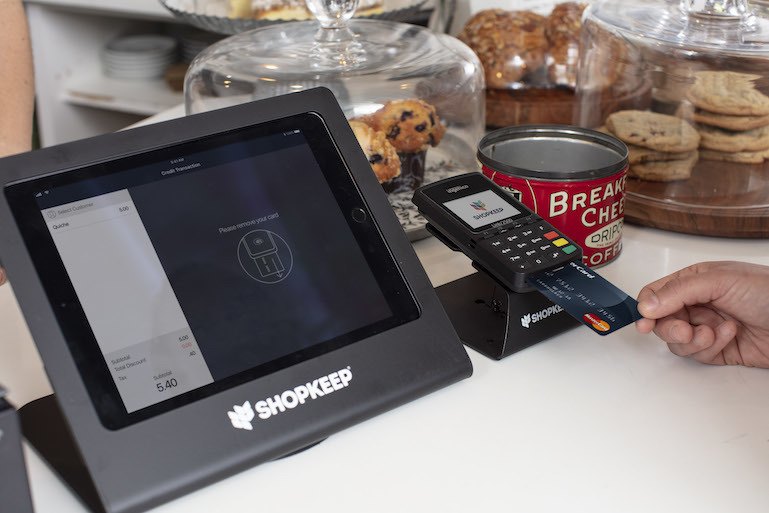
The Pros and Cons of a Cashless Business
When was the last time you heard the phrase “cash or credit?” In some markets, this phrase has become nearly obsolete as more consumers pay exclusively with credit cards and contactless payments like Apple Pay.
With more businesses experimenting with a cashless payments model, you may wonder if your small business should be one of them. In short, probably not. But let’s look at the pros and cons of a cashless business to discuss how the rise of credit cards and decline of cash are impacting our economy and society.
The Cash-Free Trend
When it comes to making purchases, credit and debit cards are more popular than ever. A 2018 survey (by Capital One, so not exactly an objective source) showed that one in four consumers rarely carry cash anymore. Younger people are driving the trend, so the number of people who don’t carry cash will probably continue to rise.
As these oft-misquoted numbers indicate, the vast majority of people still do carry paper money, and the average amount carried was $25. That doesn’t mean they are using it to make purchases, however. The survey showed that 40% of people carry cash for emergencies, and consumers are more likely to use a card for groceries, gas, and dining out. Transportation and personal care services are still likely to be cash transactions.
Like all business decisions, deciding to go cashless involves weighing the benefits against the
drawbacks. So what are the pros and cons of a cashless business?
Pro #1: Cash is Inconvenient for Customers
When a customer pays with cash, pulling money from their wallet creates friction in the payment process. They have to count the money and receive change. Sometimes there are disputes with change or too many coins. Register lines get backed up. Customers stuck behind a slow customer become addled and may leave.
With a card swipe, payment is quick and seamless. This is why 41% of millennials find cash “inconvenient” and 34% of them admit to never carrying cash.
SEE ALSO: How To Handle Long Lines and Keep Customers Happy
Pro #2: Cash is Inconvenient for a Small Business
As Simone Falcon, a restaurateur in New York City, told The Wall Street Journal that “the closing procedure takes 30 seconds” at his cashless business as opposed to over an hour at his business that still accepts paper money.
At cashless businesses, employees do not need to count the money drawer, sort tips, or reconcile the register. When a small business owner relies only on electronic payments, their entire operation becomes more streamlined and their point of sale system does all the work for them.
Pro #3: Consumers Spend More with Credit Cards
While the research varies, some studies estimate that customers spend up to 100% more when they pay with credit cards as opposed to cash. This makes sense, since the average amount of cash carried is $25.
For some people, a swipe of a card feels less tangible than taking physical money from their wallet. However, as a more cashless society evolves, collective psychology may change and retailers should not rely on this phenomenon.
Pro #4: Lower Insurance Rates and Less Theft
Theft, mainly from employees, is a real problem for small businesses. Lack of cash solves this problem, however, so cashless small businesses benefit from lower insurance rates.
Perhaps more importantly, the lack of fear from theft changes the nature of the employer/employee relationship. Just like instituting a no tipping policy intimately changes a dining experience, going cash free can result in a better relationship with your cashiers.
By not accepting cash, you’re ultimately creating a more secure business. Money laundering and tax evasion are basically impossible.
SEE ALSO: Loss Prevention: Your Key to Stopping Shoplifting
As you can see, the benefits of eschewing cash are real. But we don’t recommend going cashless just yet. At least not until you can address the pitfalls.
Con #1: Transaction Fees and Processing Fees
If you’re a small business owner in the United States, you already know that you’re at a disadvantage when it comes to credit card fees. Interchange fees alone in the States eat up an average of 2% per purchase, and there is no cap on fees, which means credit card companies set the rates. (In Europe, where fee caps are legislated in place, merchants only pay card associations up to .3% per transaction.)
One fear of moving toward a cashless society is giving credit card companies more power — essentially a monopoly — over merchant transactions. Without fee caps in place, nothing is preventing credit card companies from raising their fees as more and more businesses rely on plastic.
SEE ALSO: How To Save on Credit Card Processing Fees
Con #2: Poor Customer Service
Disgruntled customers often cause cashless pioneers to backtrack. “In Houston, Thomas Nguyen went cashless for a year and a half at his Peli Peli group of fast-casual and fine dining restaurants – until the online complaints became too much of a headache,” points out CreditCard.com. And in New York, Shake Shack experimented with kiosk ordering. It did not end well.
There is nothing more frustrating for a customer than trying to pay and not being able to. That’s why a quality POS (point of sale)e that accepts every form of payment is so important. And it’s why we’re still convinced that you should give customers all the available payment options, even if you take measures (like signage or incentives) to encourage guests to use debit and credit cards.
Con #3: It Excludes People on the Margins
If your business caters to customers on the lower end of the wealth scale, or are very young or elderly, most of your customers probably already pay in cash and are not participants in the growing cashless economy.
Do you want to turn away children handing you fistfuls of dimes for candy or groups of retirees who prefer paying in cash? Not to mention the 7% of people in the U.S. who do not have a bank account, by necessity or choice. Generally, this ‘unbanked’ population consists of low-income people and sometimes homeless people. Not giving this population the option to patronize your business can be interpreted as a form of discrimination.
The city of Philadelphia views it that way. The government there recently outlawed cashless businesses, and other cities may follow suit, essentially legislating against the possibility of a cashless society. (Massachusetts, those trend-spotters, outlawed cashless businesses years ago.)
Con #4: Sometimes Anonymity is Necessary
And the best way to be anonymous is to use cash. The Art of Manliness points out that cash gives customers a way to buy their spouses presents without the purchases appearing on their joint statements, and that using cash lets individuals operate outside the wider financial structure as a matter of freedom or principle.
Con #5: Technology Can Fail
Technology is not infallible. Internet connections fail. Natural disasters strike. Quality POS software like ShopKeep offers protection in the form of offline payment processing, but ultimately modern point of sale systems are tied to the cloud, and therefore a working internet connection. Paying with cash can still happen during emergencies like power outages.
What About All Those Cashless Predictions?
A few years ago, the cashless trend gained speed. Chains like Sweetgreen and Starbucks started going cash-free. Nearly all of the initial cashless pioneers have reverted back to letting customers pay with cash.
Today you are still more likely to come across a cash-only small business than a cash-free one. Many independent businesses are still struggling to accept the myriad payment methods consumers are already using, like credit or debit cards and mobile payments.
The verdict? Right now, cash is still king. But paper money’s throne is anything but secure.
Want to try ShopKeep for yourself?
Just answer a few easy questions.
Need help finding the right point of sale?
Just complete the form. We’ll call you right back to explain how ShopKeep can work for you.
Hit the ground running.Sprinting, in fact!
Read our free, comprehensive guide, Small Business 101, to learn all you need to know about starting a thriving business.

